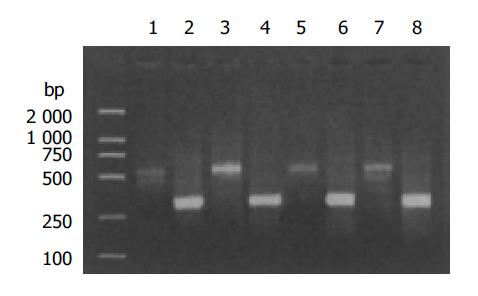Copyright
©2005 Baishideng Publishing Group Inc.
World J Gastroenterol. Apr 21, 2005; 11(15): 2269-2276
Published online Apr 21, 2005. doi: 10.3748/wjg.v11.i15.2269
Published online Apr 21, 2005. doi: 10.3748/wjg.v11.i15.2269
Figure 1 Gel electrophoresis of PCR products for TGF-b1 and GAPDH in rat liver.
Total RNA isolated from liver specimens was reverse transcribed and amplified by PCR with specific primers. As a positive control, the housekeeping GAPDH mRNA was also amplified. M (Authors: add M in the photo), Takara markers. Lines 1, 3, 5, 7 are PCR products for TGF-b1, representing the normal, model, JinSanE I and JinSanE II groups, respectively. Lines 2, 4, 6 and 8 are PCR products of GAPDH, representing the normal, model, JinSanE I and JinSanE II groups, respectively.
Figure 2 Gel electrophoresis of PCR products for TRII and GAPDH in rat liver.
Total RNA isolated from liver specimens was reverse transcribed and amplified by PCR with specific primers. As a positive control, the housekeeping GAPDH mRNA was also amplified. M (Authors: add M in the photo), Takara markers. Lines 1, 3, 5, 7 are PCR products for TRII, representing the normal, model, JinSanE I and JinSanE II groups, respectively. Lines 2, 4, 6 and 8 are PCR products of GAPDH, representing the normal, model, JinSanE I and JinSanE II groups, respectively.
Figure 3 Immunohistochemical staining for TGF-β1 in liver sections.
×400 for A, B, C and D. (A) TGF-β1 immunoreactivity was evenly distributed within the interstitial tissue and liver sinusoidal in the normal group; (B) Stout connective tissue septa were strongly immunoreactive for TGF-β1 in the model group; (C) The staining intensity was much weaker in JinSanE group I than that in the model group; and (D) The staining positivity in JinSanE group II was stronger than that in the JinSanE group II, but still less than that in the model group.
Figure 4 Immunohistochemical staining for Smad3 in liver sections.
×400 for A, B, C and D. (A) Several cells were positive for Smad3 in the normal group; (B) As TGF-β1, similarly increased Smad3 immunoreactivity was detected in the model group, but the staining degree was weak; (C) The expression was decreased in JinSanE group I, compared with the model group; and (D) Although the staining pattern for Smad3 in JinSanE group II was comparable with that observed for TGF-β1, the staining intensity was much weaker.
Figure 5 Immunohistochemical staining for Smad7 in liver sections.
×400 for A, B, C and D. (A) Normal liver displayed ubiquitous and strong staining for Smad7 in hepatocytes; (B) Weak staining of Smad7 was observed in the model group, which was in contrast to the abundant expression of TGF-β1 and Smad3 in liver of the group; (C) The staining intensity in JinSanE group I was much stronger than that in the model group, and the slender connective tissue septa were strongly immunoreactive; and (D) Strong staining for the Smad7 in JinSanE group II was observed.
-
Citation: Song SL, Gong ZJ, Zhang QR, Huang TX. Effects of Chinese traditional compound, JinSanE, on expression of TGF-β1 and TGF-β1 type II receptor mRNA, Smad3 and Smad7 on experimental hepatic fibrosis
in vivo . World J Gastroenterol 2005; 11(15): 2269-2276 - URL: https://www.wjgnet.com/1007-9327/full/v11/i15/2269.htm
- DOI: https://dx.doi.org/10.3748/wjg.v11.i15.2269

















